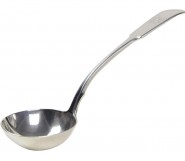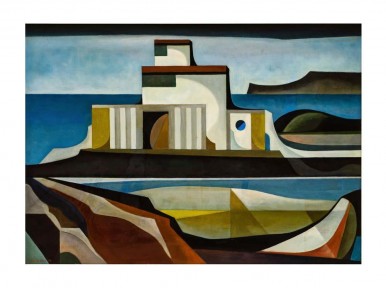Lot #13 - Charles Tole
-
Auction House:Mossgreen-Webb's
-
Sale Name:Important Paintings & Contemporary Art
-
Sale Date:29 Nov 2016 ~ 6.30pm (NZ time)
-
Lot #:13
-
Lot Description:Charles Tole
Surf Club
oil on hardboard, 1970
605mm x 850mm
signed CHARLES TOLE and dated '70 in brushpoint lower left; printed TITLE: 'SURF CLUB ' / NAME: CHARLES TOLE / ADDRESS: 12, Seaview Road, Remuera, Akld 5. / MEDIUM: OIL / SUPPORT: HARDBOARD / DIMENSIONS: 34 x 24 1/2 / YEAR PAINTED: 1970 / SIGNED: 'Charles Tole ' / PRICE: on original typed artist 's label affixed verso. -
Provenance:Formerly in the collection of Les and Milly Paris, Wellington; Purchased by the present owner from the The Les and Milly Paris Collection, Art + Object, September 2012.
-
Notes:Charles Tole (1903-88) is an unusual example of an artist without formal training as he does not follow the naturalistic style favoured by most amateur artists. Instead, Tole engages with a more experimental approach related to that seminal movement of early modernism, cubism. Working with the Auckland-based Thornhill Group, he came under the influence of John Weeks, as did his older brother John, who probably initiated Charles' efforts as an artist. Weeks, who had worked in Paris and had direct knowledge of cubism, introduced modernism to many fellow artists in New Zealand, as well as to his students at the Elam School of Fine Arts. The style that Charles Tole adopted is typical of that of later adherents to cubism, who concentrated on simplifying their paintings into the stylised forms that had initially given the movement its name - a derogatory reference to the little 'cubes' of analytic cubist works. The resulting, somewhat decorative, quality often associated with art deco in the mid-century, is heightened in Tole's work because he avoids the limited, almost monochromatic, earth tones in Picasso's and Braque's still life and landscape studies of the end of the first decade. Tole preferred a brighter, multi-coloured palette, which recalls the post-cubist colour experiments of Orphism. Tole's subject matter also differentiates him from the founder cubists as he particularly favoured urban and industrial scenes with the squared profiles of factory buildings and tall chimneys. In Surf Club , while the subject is more recreational, the clubhouse lends itself to his cubist interests; the piled-up rectangular shapes of the superstructure are also reminiscent of a small boat, like those that children fashion from graduated blocks of wood. The composition is divided into planar bands, defining sea and land, while the foreshore of sand dunes and cliffs provides more organic forms that contrast with the strong horizontal lines and the rectilinear architecture. But, because they, too, are simplified and stylised, they complement the angular forms admirably, avoiding a reductive sense of geometry. As Tole and his brother put it: We have always been intensely interested in modern developments in style and technique, yet we think these elements should not be arbitrarily or consciously striven for but should emerge and flow freely from the subject matter and from the artist's creative intuition towards the expression and communication of his message. (Quoted on the Auckland Art Gallery website) He was near 40 when he first began painting but, although a late starter, Charles Tole had a long and productive career as an artist, still painting and exhibiting into his 80s. A show entitled Eight Paintings of 1974 through 1982 at the Peter McLeavey Gallery was picked out as a noteworthy exhibition by reviewer Avenal McKinnon in Art New Zealand 25 . So although Surf Club, dated 1970, was painted when Tole was in his late 60s, it could be said that it is a mid-career work and it is an engaging example of his mature style. Elizabeth Rankin
-
Estimate:NZ$45,000 - 55,000
-
Realised Price:
-
Category:Art
This Sale has been held and this item is no longer available. Details are provided for information purposes only.










